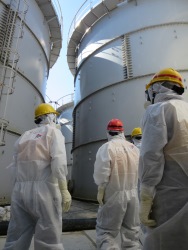Fukushima leak cleaned up
27 August 2013
ORIGINALLY PUBLISHED: 4.50pm, 27 August
UPDATE 1: 10.07am, 28 August: Box on new provisional INES rating
CORRECTION: 5.44pm, 29 August: Faulty tank contained water with 200,000 Bq/L. Previous figure of 80 million Bq/L was measurement of leaked water accumulated within the dam.
Extensive measures to prevent and mitigate potential spills of radioactive water from storage tanks are being put in place at Fukushima Daiichi. The clean-up of a previous leak appears to have been successful.
 |
| Sporting a VIP red hard hat, minister Toshimitsu Motegi tours the Fukushima Daiichi site and the storage area, inspecting flange tanks like the one that leaked |
Partially treated radioactive water leaked from a storage tank last week, going on to escape from a surrounding dam through a rainwater valve. Having discovered this on 20 August, Tokyo Electric Power Company (Tepco) has now pumped away excess water and cleared soil from the affected area to a depth of 50 centimetres, reporting that there is no sign of contamination at that depth.
The company has also increased its monitoring of drainage channels that take rainwater to sea. Where these meet the sea, caesium-134 and beta radiation were below the limits of detection while caesium-137 was found at a trace amount of 18 becquerels per litre (Bq/l). This is less radioactivity per litre than naturally present in one banana. Further inland, nearer to the faulty tank, there was no detected caesium while beta radiation was at 93 Bq/L. This compares to some 200,000 Bq/L in water sampled from the faulty tank, indicating this is not reaching the sea in any significant quantity, if at all.
One theory for the tank's failure relates to the fact that it is one of three to have been dismantled, moved and reassembled after their original positions suffered subsidence. It is thought this may have weakened a flange seal in some way, despite careful testing on reassembly. As a precaution, the company is now draining another of the moved tanks and preparing to drain the remaining one.
All flange tanks will in future be subject more regular inspection, with patrols upped to include 50 staff - all carrying radiation dose meters. Thermal cameras will be trained on the tanks, giving an indication of the water levels due to influence of water temperature on the tank surface temperature. There will be a routine for the staff to quickly document any 'suspicious' puddles of water. Rainwater valves will also be kept closed by default instead of open.
INES ratings saga
The leak was given a preliminarily classification on 20 August by the Nuclear Regulatory Authority (NRA) as a Level 1 'anomaly' on the International Nuclear Event Scale.
However, on the same day, the NRA caused confusion with conflicting announcements, first highlighting the potential revision to Level 3 - a 'serious incident' - then admitting that it did not know whether the leak should be recorded separately or counted as part of the overall accident, already rated as a 'major accident' at Level 7. The regulator said it would consult with the International Atomic Energy Agency, which responded on 21 August by saying it had not yet been approached.
On 28 August after consultation the NRA announced a new provisional rating of Level 3.
Work remains to clean up the concrete pad on which the tanks are sited, where high dose rates of 70 and 100 milliSieverts per hour were found in two spots. Some rainwater valves on the other side of the storage area showed higher dose rates of 4.0 and 16.0 milliSieverts per hour. The soil in those areas shows no contamination, said Tepco, which plans to remove it anyway.
Outside the storage tank area the company has taken further measures to mitigate any future spill. A bank of earth has been raised around the perimeter with waterproof sheets and rubber mats beyond that. In future it is possible that the flange tanks will be replaced with another design.
Paying a visit to the site yesterday the minister for Economy, Trade and Industry, Toshimitsu Motegi, expressed the government's anger over the leak during his 'encouragement' to site staff. He reportedly said that government should take more control over the site, although Tepco has already been effectively nationalised to meet the costs of the accident.
Researched and written
by World Nuclear News